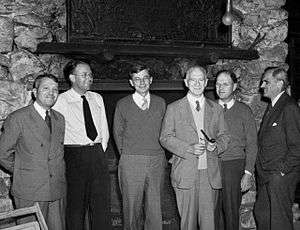Eger V. Murphree
Eger Vaughan Murphree (November 3, 1898 – October 29, 1962) was an American chemist, best known for his co-invention of the process of fluid catalytic cracking.[1]

Biography
He was born on November 3, 1898 in Bayonne, New Jersey, moving as a child to Kentucky. He graduated from Kentucky University with degrees in chemistry and mathematics in 1920, and a master's degree in chemistry in 1921. After teaching school for a year he spent several years at the Massachusetts Institute of Technology as a Staff Assistant and Research Associate in the Chemical Engineering Department. In 1930 he joined what was then Standard Oil of New Jersey.[2]
During the Second World War Murphree was a member of the committee that organized the Manhattan Project and was widely recognized as a leader in the fields of synthetic toluene, butadiene and hydrocarbon synthesis, fluid cat cracking, fluid hydroforming, and fluid coking.
He was also involved in the early Manhattan Project as a member of the S-1 Section. Murphree was head of the centrifuge project (soon abandoned) and overall engineer for the Manhattan Project in June 1942. He struck Deputy District Engineer Kenneth Nichols as "more like the industrial engineers I was accustomed to dealing with. He was stable, conservative, thorough and precise". He was to have been on the Lewis Committee reviewing the entire project in November 1942, but was sick. He (and James Conant) disagreed with the committee recommendation to build only a small electromagnetic plant, and a full-size plant was built. In the 1950s he served in the Defence Department on scheduling missiles and coordinating the programs of the three services (as Nichols had done earlier).[3]
From 1947 to 1962 he served as Vice President of research and engineering at Exxon, as Standard Oil had become.
Among his awards were the Perkin Medal in 1950 and the Industrial Research Institute (IRI) Medal in 1953. The E. V. Murphree Award in Industrial and Engineering Chemistry awarded annually by the American Chemical Society is named in his honor.
He died on October 29, 1962 at Overlook Hospital in Summit, New Jersey of coronary thrombosis.[1]
Legacy
He was inducted into the National Inventors Hall of Fame in 1999.
References
- "Eger V. Murphree Dies at 63. Led Esso Research Company. Chemist Helped Establish the Manhattan District Project. Held 39 Patents". The New York Times. October 30, 1962.
- "Historical records matching Eger V. Murphree". Retrieved 16 August 2015.
- Nichols, Kenneth (1987). The Road to Trinity: A Personal Account of How America’s Nuclear Policies Were Made. New York: William Morrow. pp. 32, 69. ISBN 068806910X.
External links
- Eger V. Murphree
- U.S. Patent 2,451,804 Method of and Apparatus for Contacting Solids and Gases, October 19, 1948
- Eger V. Murphree — Biographical Memoirs of the National Academy of Sciences